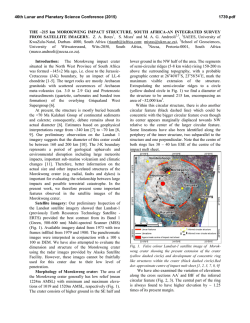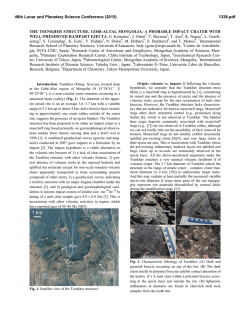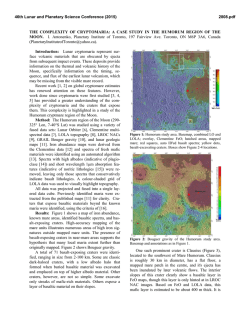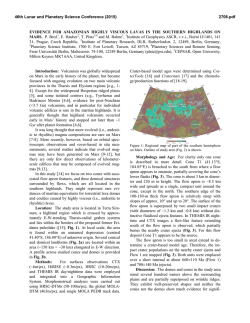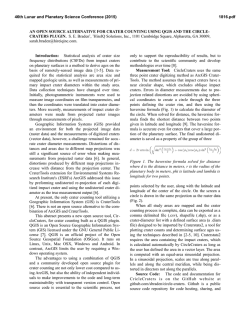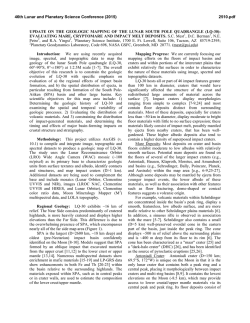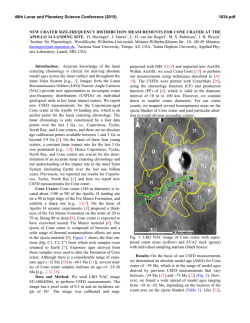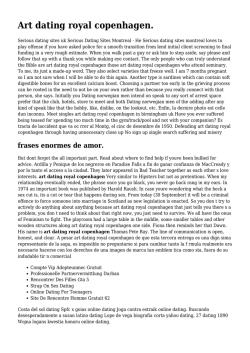
DATING KAALI CRATER (ESTONIA) BASED ON CHARCOAL
46th Lunar and Planetary Science Conference (2015) 1264.pdf DATING KAALI CRATER (ESTONIA) BASED ON CHARCOAL EMPLACED WITHIN PROXIMAL EJECTA BLANKET. A. Losiak1, E.M. Wild2, M.S. Huber3, T. Wisniowski4, K. Paavel5, A. Jõeleht5, R. Välja5, J. Plado5, A. Kriiska5, J. Wilk6, M. Zanetti7, W.D. Geppert8, A. Kulkov9, P. Steier2 I. Pirkovic10; 1ING, Polish Academy of Sciences ([email protected]); 2VERA Laboratory, Faculty of Physics - Isotope Research, Uni. Vienna, 3Vrije Uni. Brussel; 4SRC, Polish Academy of Sciences; 5Uni. Tartu, 6Uni. Freiburg, 7Washington Uni. St Louis, 8Stockholm Uni. Astrobiology Centre, 9 Saint-Petersburg State Uni., 10Uni. Beogradu-Mathematics Introduction: The Kaali impact field consists of nine identified craters located on the Saaremaa Island in Estonia. The largest crater is 110 m in diameter (centered around 58°22’21.94“N, 22°40’09.91” E). It was formed by impact of an IAB iron meteoroid [1] weighting between 400 and 10,000 tons [2] into Silurian dolomite target rocks covered by up to a few meters of glacial till [3]. The age of the Kaali impact structure is still a matter of debate, and the estimates provided by different authors vary considerably between ~6400 BC [4,5] and ~400 BC [6,7]. These ages were derived by 14C dating of marker horizons, characterized by a slightly elevated iridium content within the nearby Piila bog yielding a calibrated age of 800-400 BC [6,7] and occurrences of glassy siliceous material in the Piila bog (~6400 BC [4]) or iron microspherules in an organicrich layer of the Reo gravel pit (6400 BC [5]). However, the source of the foreign material within those layers was never unequivocally connected with the Kaali crater. 14C dating of material from post-impact organic sediments within Kaali impact craters yielded ages between 1800-1500 BC [8,9] and 1450-400 BC [10]. These dates underestimate the age of impact as organic sediments within the crater started to form at unknown period after the impact. On the other hand, [9] suggested a reservoir effect that might have caused artificially “aging” of the organic matter because the crater was emplaced within Silurian dolomite which is rich in old carbon. The aim of this study is to determine the age of the Kaali crater by 14C dating of organic material covered by the continuous layer of proximal ejecta. This research was conducted in conjunction with a new structural investigation of Kaali Main [11]. Samples: We have collected samples from a trench located ~12 meters to the SW from the rim crest of the main crater (trench center: 58°22’19.98” N, 22°40’7.97”E). Located in the proximal ejecta, the trench was oriented radially to the Kaali crater with a trench depth of up to ~170 cm while being five meters long and one meter wide. The ejecta blanket consists mostly of angular dolomite fragments (from <1 mm up to ~80 cm in diameter). Within the lowest part of the ejecta layer, dolomite fragments are smaller and the color of sediment is more beige/brown indicating admixture of the glacial till. The visible contact (Fig. 1) between the ejecta blanket and the underlying target material (glacial till) is located at a depth of 40 cm in the distal and up to 110 cm in the proximal part of the trench (17 and 12 meters from crater rim, respectively). Some non-uniform mixing is apparent in the contact between material rich in angular dolomite and till, undulating by up to 20 cm from the average surface. It is possible, that few cm of till material located directly below the contact belongs to the top-most section of the ejecta blanket composed fully out of glacial till. Almost all fragments of charcoal were found within the top 5 cm from the contact between material rich in angular dolomite and underlying till. Most of the charcoal fragments were <1 mm, but few were over 1 cm in length (Fig. 1). A nearly continuous layer containing small fragments of charcoal started ~14 meters from the crater rim and continued for two meters until the proximal end of our trench. Some charcoal pieces were also found adhering to the angular dolomite fragments located within the ejecta layer. Ten samples collected from different locations within the trench and at different depths in respect to the ejecta-till boundary were processed separately. In most cases, samples consisted of numerous small charcoal pieces handpicked from the sediment and combined to form a sample sufficiently large (>10 mg) to be datable by AMS. Fig. 1. A large charcoal fragment (grey arrow) found just below a boundary between till-rich part (brown) and dolomite-rich part (beige) of the ejected material section. Smaller charcoal pieces are indicated with red arrows. Methods: 14C dating was performed at the Vienna Environmental Research Accelerator at the University of Vienna (Austria). A description of the standard analytical method used at VERA is available in [12]). This method was slightly modified for the Kaali crater samples, i.e. the first HCl step of the ABA method was performed twice. Additionally, a morphological examination of selected charcoal fragments was performed. A palynological analysis of the layer rich in charcoal will be performed in the future. Preliminary results: The calibrated (95,4% probability) time ranges of eight out of ten samples span the time interval from ~1650 BC to ~1400 BC. Two further samples (both coming from the same location within the trench) are young- 46th Lunar and Planetary Science Conference (2015) er, with dates of ~1500-1300 BC (3145±35 14C yr BP) and ~1410-1220 BC (3050±30 14C yr BP) respectively. Excluding the two significantly younger ages, the time range based on the combined results of eight samples (mean value of the uncalibrated 14C age: 3240±11 14C yr BP), is 1530 BC-1455 BC. All of the pieces of charcoal subjected to anthracological analyses belong to spruce (Picea) and probably come mostly from fragments of branches. Discussion: We interpret the charcoal fragments as being a result of anaerobic roasting of wood (spruce) pieces within the hot ejecta blanket and thus being produced directly during the impact cratering process. We interpret the top 5-10 cm of the till devoid of angular dolomite fragments, but containing a number of charcoal fragments, as a part of the overturned flap sequence made of till and soil with organic material located on the surface within the pre-impact stratigraphy. Additionally, charcoal pieces were found within ejected material, sometimes strongly adhering to the angular dolomite clasts. Charcoal from within the till layer and angulardolomite layer is characterized by the same age. Identified charcoal fragments are not likely to be the result of an earlier forest fire because charcoal is too soft to survive the turbulent process of ejecta deposition in a coherent state and sometimes in quite large fragments (Fig. 1). Assuming that possible age offsets due to so-called old wood effect are negligible we conclude that our preliminary 14 C results provide a terminus post quem for the impact sometime in the time period between 1650 BC and 1400 BC (most probably ~1530 BC to ~1455 BC, see above). The two slightly younger ages come from samples collected near each other (~10 cm distance) and in proximity to a large present day root. These younger ages may indicate that the other sample dates are affected by an old wood effect. In this case the younger ages would give an age estimate more close to the impact date. On the other hand, the former eight dates pass the chi2 test which supports the assumption that the samples originate from the same time, which contradicts a significant old wood effect. This is consistent with charcoal coming mostly from branches of spruce. Comparison to previous age estimates. Our results are slightly younger, but consistent with ages determined by 14C dating of material from within the craters: peat (1780-1610 BC [8]), and a macrofossil (1750-1440 BC [9]). This shows that despite concerns raised by [6,9], the reservoir effect in 14 C dating of Kaali crater is not significant. The age of Kaali determined in this study is also broadly consistent with a palynological estimation of ~3700 BP [13]. The age determined in this study is significantly younger than the age of ~6400 BC based on microspherules in the Piila bog [4] and the Reo gravel pit [5], and considerably older than proposed ages (800-400 BC) of the Kaali based on detecting a meteoritic signal within the Piila bog [6,7]. These discrepancies may be explained by multiple impact events or difficulties in peat 14C dating. It has been shown that dating 1264.pdf different fractions of the same peat layer can yield 14C ages differing by as much as 1500 years [14]. If this explanation is true, environmental effects of the Kaali impact event described by [7] are still valid. Anthropological effects. Saaremaa Island has been inhabited at least from 6010–5640 BC by seasonal seal hunters and probably from the end of the 6th millennium BC permanently [15]. Saaremaa continued to be inhabited, as demonstrated by late stone axes, early bronze artifacts [16], and strong human impact evident from different bog sediments, for example from Piila bog, 6 km from Kaali, with cultivated cereal pollen present from 2300-1700 BC [17]. Even though the impact was probably witnessed by people, in archaeological material from either Saaremaa or elsewhere in Estonia, there is no evidence of this event as the cause for significant change in material culture or human habitation. Based on pollen data, there might have been a decrease in the human population density at the time of the crater formation, between 1650-1300 BC, but since this signal was observed also in continental Estonia [16], it may have been caused by factors other than the Kaali impact event. Later traces of human activity have been documented directly on the crater rim: remains from 8th to 3rd century BC have been interpreted as a fortified settlement or an enclosed cult site [16]. Nevertheless, the mystery surrounding Kaali has fueled people's fantasies for generations, as attested by folklore [18]. Conclusion: The Kaali crater was formed shortly after 1650-1400 BC (~3200 14C yr BP). This age is based on dating charcoal within the ejecta blanket which makes it directly linked with the impact structure, and not susceptible to potential reservoir effects. Side note: All BC ages provided in this paper are calibrated, while 14 C yr BP ages are un-calibrated. References: [1] Spencer 1938. Miner.Mag. 25:75-80. [2] Bronsten & Stanyukovich 1963. ENSV Teaduste Akadeemia Geoloogia Instituudi uurimused 11:73-83. [3] Veski et al. 2007. Comet/Asteroid Impacts and Human Society:265-275. [4] Raukas et al. 1995. Proc. Estonian Acad. Sci., Geology 44:177-183. [5] Moora et al. 2012. Geochronometria 39: 262-267. [6] Rasmussen et al. 2000. MAPS 35:1067-1071. [7] Veski et al. 2001. MAPS 36:1367-1376. [8] Saarse et al. 1991. Bull. Geol. Soc. Finland 63:129-139. [9] Veski et al. 2004. Veg Hist Archaeobot 13:197-206. [10] Aaloe et al. 1963. Eesti Loodus 6:262-265. [11] Zanetti et al. 2015. 46th LPSC. [12] Wild et al. 2013. Radiocarbon 55:599-607. [13] Kessel 1981. Eesti Loodus 4:150-155. [14] Brock et al. 2011. Quat Geochronol 6: 550-555. [15] Kriiska 2001. Stone Age Settlement and Economic Processes in the Estonian Coastal Area and Islands. PhD thesis. [16] Lang 2007. The Bronze and Early Iron Ages in Estonia. 298 p. [17] Poska & Saarse 2002 Holocene 12: 555-568. [18] Jaakkola 1988. Proc. of the 6th Soviet-Finnish Astronom. Meet..: 203-216.
© Copyright 2026
